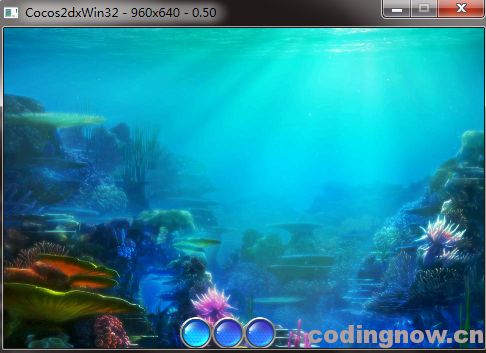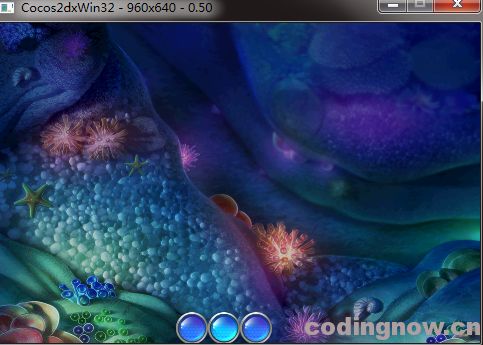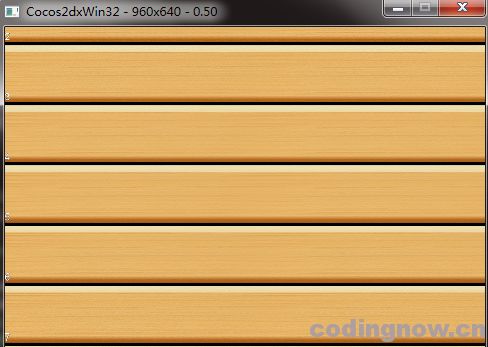cocos2d-x CCScrollView和CCTableView的使用
转载请注明来自:Alex Zhou的程序世界,本文链接:http://codingnow.cn/cocos2d-x/1024.html
//==================================================================================
在游戏和应用中经常要实现左右滑动展示游戏帮助、以列表显示内容的UI效果,就像android中的Gallery和ListView。本文通过CCScrollView和CCTableView分别来实现这两个效果,基于cocos2d-x 2.0.4版本。
首先来简单了解一下这两个东东,CCScrollView本身是一个CCLayer,而CCTableView是CCScrollView的子类,这是引擎已经帮我们封装好了的,CCTableView可以设置成横向和纵向,用它可以实现类似于Gallery和ListView的效果。
1. 首先实现游戏帮助界面
(1) 创建头文件GalleryLayer.h
class GalleryLayer : public cocos2d::CCLayer ,public CCScrollViewDelegate
{
public:
virtual bool init();
void menuCloseCallback(CCObject* pSender);
CREATE_FUNC(GalleryLayer);
public:
//scrollview滚动的时候会调用
void scrollViewDidScroll(CCScrollView* view);
//scrollview缩放的时候会调用
void scrollViewDidZoom(CCScrollView* view);
virtual void onEnter();
virtual void onExit();
virtual bool ccTouchBegan(CCTouch *pTouch, CCEvent *pEvent);
virtual void ccTouchMoved(CCTouch *pTouch, CCEvent *pEvent);
virtual void ccTouchEnded(CCTouch *pTouch, CCEvent *pEvent);
virtual void ccTouchCancelled(CCTouch *pTouch, CCEvent *pEvent);
private:
//根据手势滑动的距离和方向滚动图层
void adjustScrollView(float offset);
CCScrollView *m_pScrollView;
CCPoint m_touchPoint;
int m_nCurPage;
};
类GalleryLayer继承了CCScrollViewDelegate,实现了它的两个纯虚函数,主要是为了当scrollview滚动和缩放时回调这两函数,这样我们就可以在这两函数中做相关操作了。
(2) 看源文件GalleryLayer.cpp
#include "GalleryLayer.h"
#include "ListViewLayer.h"
using namespace cocos2d;
using namespace cocos2d::extension;
bool GalleryLayer::init()
{
bool bRet = false;
do
{
CC_BREAK_IF( !CCLayer::init() );
m_nCurPage = 1;
CCSize visibleSize = CCDirector::sharedDirector()->getVisibleSize();
CCPoint origin = CCDirector::sharedDirector()->getVisibleOrigin();
CCLayer *pLayer = CCLayer::create();
char helpstr[30] = {0};
for (int i = 1; i <= 3; ++ i)
{
memset(helpstr, 0, sizeof(helpstr));
sprintf(helpstr,"bg_%02d.png",i);
CCSprite *pSprite = CCSprite::create(helpstr);
pSprite->setPosition(ccp(visibleSize.width * (i-0.5f), visibleSize.height / 2));
pLayer->addChild(pSprite);
}
m_pScrollView = CCScrollView::create(CCSizeMake(960, 640), pLayer);
m_pScrollView->setContentOffset(CCPointZero);
m_pScrollView->setTouchEnabled(false);
m_pScrollView->setDelegate(this);
m_pScrollView->setDirection(kCCScrollViewDirectionHorizontal);
pLayer->setContentSize(CCSizeMake(960*3, 640));
this->addChild(m_pScrollView);
CCSpriteFrameCache *pCache = CCSpriteFrameCache::sharedSpriteFrameCache();
pCache->addSpriteFrame(CCSpriteFrame::create("button_normal.png",CCRectMake(0, 0, 64, 64)),"button_normal.png");
pCache->addSpriteFrame(CCSpriteFrame::create("button_selected.png",CCRectMake(0, 0, 64, 64)),"button_selected.png");
for (int i = 1; i <= 3; ++ i)
{
CCSprite *pPoint = CCSprite::createWithSpriteFrameName("button_normal.png");
pPoint->setTag(i);
pPoint->setPosition(ccp( origin.x + (visibleSize.width - 3 * pPoint->getContentSize().width)/2 + pPoint->getContentSize().width * (i-1), origin.y + 30));
this->addChild(pPoint);
}
CCSprite *pPoint = (CCSprite *)this->getChildByTag(1);
pPoint->setDisplayFrame(pCache->spriteFrameByName("button_selected.png"));
bRet = true;
}while(0);
return bRet;
}
void GalleryLayer::menuCloseCallback(CCObject* pSender)
{
}
void GalleryLayer::scrollViewDidScroll(cocos2d::extension::CCScrollView *view)
{
CCLOG("scroll");
}
void GalleryLayer::scrollViewDidZoom(cocos2d::extension::CCScrollView *view)
{
CCLOG("zoom");
}
void GalleryLayer::onEnter()
{
CCLayer::onEnter();
CCDirector::sharedDirector()->getTouchDispatcher()->addTargetedDelegate(this, 1, false);
}
void GalleryLayer::onExit()
{
CCDirector::sharedDirector()->getTouchDispatcher()->removeDelegate(this);
CCLayer::onExit();
CCSpriteFrameCache::sharedSpriteFrameCache()->removeUnusedSpriteFrames();
}
bool GalleryLayer::ccTouchBegan(CCTouch *pTouch, CCEvent *pEvent)
{
m_touchPoint = CCDirector::sharedDirector()->convertToGL(pTouch->getLocationInView());
return true;
}
void GalleryLayer::ccTouchMoved(CCTouch *pTouch, CCEvent *pEvent)
{
}
void GalleryLayer::ccTouchEnded(CCTouch *pTouch, CCEvent *pEvent)
{
CCPoint endPoint = CCDirector::sharedDirector()->convertToGL(pTouch->getLocationInView());
float distance = endPoint.x - m_touchPoint.x;
if(fabs(distance) > 50)
{
adjustScrollView(distance);
}
}
void GalleryLayer::ccTouchCancelled(cocos2d::CCTouch *pTouch, cocos2d::CCEvent *pEvent)
{
CCPoint endPoint = CCDirector::sharedDirector()->convertToGL(pTouch->getLocationInView());
float distance = endPoint.x - m_touchPoint.x;
if(fabs(distance) > 50)
{
adjustScrollView(distance);
}
}
void GalleryLayer::adjustScrollView(float offset)
{
CCSize visibleSize = CCDirector::sharedDirector()->getVisibleSize();
CCPoint origin = CCDirector::sharedDirector()->getVisibleOrigin();
CCSpriteFrameCache *pCache = CCSpriteFrameCache::sharedSpriteFrameCache();
CCSprite *pPoint = (CCSprite *)this->getChildByTag(m_nCurPage);
pPoint->setDisplayFrame(pCache->spriteFrameByName("button_normal.png"));
if (offset<0)
{
m_nCurPage ++;
}else
{
m_nCurPage --;
}
if (m_nCurPage <1)
{
m_nCurPage = 1;
}
if(m_nCurPage > 3)
{
CCLayer *pLayer = ListViewLayer::create();
CCScene *pScene = CCScene::create();
pScene->addChild(pLayer);
CCDirector::sharedDirector()->replaceScene(pScene);
}
else
{
pPoint = (CCSprite *)this->getChildByTag(m_nCurPage);
pPoint->setDisplayFrame(pCache->spriteFrameByName("button_selected.png"));
CCPoint adjustPos = ccp(origin.x - visibleSize.width * (m_nCurPage-1), 0);
m_pScrollView->setContentOffset(adjustPos, true);
}
}
这里一共有三张图,是从捕鱼达人中拿出来的背景图,当滚完三张图时就跳转到ListViewLayer场景去,上面的代码比较容易懂。
首先创建一个CCLayer,包含三张背景图,设置CCLayer的ContentSize,并设置三张图片的位置
然后设置CCLayer为CCScrollview的内容,并设置CCScrollView的显示区域。
最后根据用户滑动的方向和距离,通过设置scrollview的setContentOffset,滚动视图。
CCScrollview.h文件中封装了一个枚举类型,一共有四个方向,常用横向和纵向,这里使用了横向。
typedef enum {
kCCScrollViewDirectionNone = -1,
kCCScrollViewDirectionHorizontal = 0,
kCCScrollViewDirectionVertical,
kCCScrollViewDirectionBoth
} CCScrollViewDirection;
下面来看看这部分的效果:

2. 现在来实现列表展示(ListView)的效果
(1)创建ListViewLayer.h
#include "cocos2d.h"
#include "cocos-ext.h"
class ListViewLayer : public cocos2d::CCLayer, public cocos2d::extension::CCTableViewDataSource, public cocos2d::extension::CCTableViewDelegate
{
public:
virtual bool init();
virtual void scrollViewDidScroll(cocos2d::extension::CCScrollView* view);
virtual void scrollViewDidZoom(cocos2d::extension::CCScrollView* view);
//处理触摸事件
virtual void tableCellTouched(cocos2d::extension::CCTableView* table, cocos2d::extension::CCTableViewCell* cell);
//每一项的宽度和高度
virtual cocos2d::CCSize cellSizeForTable(cocos2d::extension::CCTableView *table);
//生成列表每一项的内容
virtual cocos2d::extension::CCTableViewCell* tableCellAtIndex(cocos2d::extension::CCTableView *table, unsigned int idx);
//一共多少项
virtual unsigned int numberOfCellsInTableView(cocos2d::extension::CCTableView *table);
CREATE_FUNC(ListViewLayer);
};
ListViewLayer继承了CCTableViewDataSource和CCTableViewDelegate。这两个抽象类封装了几个有用的函数,我们在下面的源码中将实现它们。
(2)源文件 ListViewLayer.cpp
bool ListViewLayer::init()
{
bool bRet = false;
do
{
CC_BREAK_IF( !CCLayer::init() );
CCTableView* pTableView = CCTableView::create(this, CCSizeMake(960, 640));
pTableView->setDirection(kCCScrollViewDirectionVertical);
pTableView->setPosition(CCPointZero);
pTableView->setDelegate(this);
pTableView->setVerticalFillOrder(kCCTableViewFillTopDown);
this->addChild(pTableView);
pTableView->reloadData();
bRet = true;
}while(0);
return bRet;
}
void ListViewLayer::tableCellTouched(CCTableView* table, CCTableViewCell* cell)
{
CCLog("cell touched at index: %i", cell->getIdx());
}
CCSize ListViewLayer::cellSizeForTable(CCTableView *table)
{
return CCSizeMake(960, 120);
}
CCTableViewCell* ListViewLayer::tableCellAtIndex(CCTableView *table, unsigned int idx)
{
CCString *pString = CCString::createWithFormat("%d", idx);
CCTableViewCell *pCell = table->dequeueCell();
if (!pCell) {
pCell = new CCTableViewCell();
pCell->autorelease();
CCSprite *pSprite = CCSprite::create("listitem.png");
pSprite->setAnchorPoint(CCPointZero);
pSprite->setPosition(CCPointZero);
pCell->addChild(pSprite);
CCLabelTTF *pLabel = CCLabelTTF::create(pString->getCString(), "Arial", 20.0);
pLabel->setPosition(CCPointZero);
pLabel->setAnchorPoint(CCPointZero);
pLabel->setTag(123);
pCell->addChild(pLabel);
}
else
{
CCLabelTTF *pLabel = (CCLabelTTF*)pCell->getChildByTag(123);
pLabel->setString(pString->getCString());
}
return pCell;
}
unsigned int ListViewLayer::numberOfCellsInTableView(CCTableView *table)
{
return 20;
}
void ListViewLayer::scrollViewDidScroll(CCScrollView *view)
{
}
void ListViewLayer::scrollViewDidZoom(CCScrollView *view)
{
}
首先需要创建CCTableView,设置它的显示区域和显示方向,这里使用了纵向。设置每个子项的宽度和高度,子项的数量以及每个子项对应的内容。每个子项是一个CCTableViewCell,这里进行了优化,复用了子项对象。
下面是效果图:
